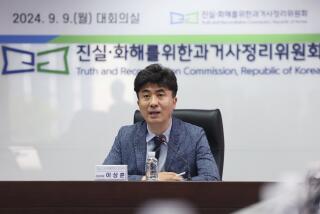Bruce Rappaport, 64; trailblazer in open adoption
- Share via
Bruce M. Rappaport, a trailblazer in the open-adoption movement who pushed for the right of birth and adoptive parents to choose and know each other decades before it became the norm, has died. He was 64.
Rappaport died Oct. 27 after a brief illness at Kaiser Permanente Medical Center in Walnut Creek, Calif., said Kathleen Silber, associate executive director of the Independent Adoption Center in Pleasant Hill, Calif., which Rappaport founded in 1982.
“He was very passionate about adoptions occurring with truth and not with secrecy,” Patricia Martinez Dorner, an author and national advocate for open adoption, told The Times. “He was a strong voice from the early days who was able to convey his position with great passion.”
Silber, who also is recognized as an open-adoption pioneer, said that “the whole field of adoption has changed basically in a generation, and a lot of that had to do with dynamic leadership such as Bruce’s.”
The trend toward openness started in the late 1960s when adults who were adopted as children began demanding to know about their heritage, Rappaport noted in several interviews. They were children of closed adoptions, which dated to the 1940s and prevented ties between birth and adoptive parents, shrouding the process in secrecy and making it seem taboo, he often said.
The term “openness” is, “unfortunately, a scare word that sounds like some crazy thing ... like ‘open marriage,’ ” Rappaport told The Times in 1996. “For years, we tried to call it ‘normalized’ adoption because it means approaching adoption the same way you do the regular part of your life.”
Rappaport’s adoption activism grew out of his job as director of a Bay Area infertility clinic. When couples learned that further medical treatments made little sense, they often asked him where to turn next. He knew the odds of adopting quickly through a state or county agency were against them.
With the legalization of abortion and increased societal acceptance of unwed mothers, the percentage of women with unplanned pregnancies who placed their children for adoption had shrunk to 3% in the 1980s, down from 60% in the 1960s, according to the center.
Part of the reason was that young women raised during the feminist movement balked at having no say in their child’s future and at the secretive process of traditional agency adoptions, Rappaport often said.
With a group of colleagues from the clinic, he established the nonprofit adoption center to challenge the status quo. Later, a branch was opened in Los Angeles. In 1990, he also founded the National Federation for Open Adoption Education to sponsor national conferences and educate other agencies.
In “The Open Adoption Book,” a guide he wrote in 1992, Rappaport tried to demystify the process, explaining simply: “Open adoption is primarily about relationships” between birth and adoptive parents and birth parents and child. For instance, the adoptive parents are invited to attend the birth, while birth parents can stay in touch, to varying degrees, for the rest of the child’s life.
The book traced the initial push for open adoption to “The Adoption Triangle,” a 1978 book by three social workers and therapists that he said “told story after story about the destructiveness of closed adoption.”
For years, Rappaport’s approach was considered cutting-edge. It combined the speed of independent adoption, which was often done through lawyers, with counseling for the birth mother and adoptive parents.
“His stand on openness was downright belligerent. He was going to make it change, and he did,” said Loretta Sochor, the center’s administrative director.
During the center’s first decade, employees were considered “absolute outlaws and literally shunned by the adoption world,” Rappaport wrote in a farewell to the center upon retiring this fall. “But after about 20 years, the victory is pretty complete.”
According to current estimates, close to 80% of voluntary infant adoptions in the U.S. are open to some extent, he wrote. “When I ask open adoptees what open adoption means to them, they say they don’t know,” Rappaport said in a 2000 Houston Press story. “They find the question boring. Because for them there is no other way to do it. And that’s the sign that’s really powerful. It’s normal.”
Born in New Jersey in 1942, Rappaport earned bachelor’s and master’s degrees from the University of Chicago and a doctorate in political science from UC Berkeley. He had been on the faculty of San Francisco State University.
Although he had a biological daughter, Rappaport said he could relate to couples who desperately wanted to adopt. He and his wife had spent seven years fighting infertility.
After finally becoming a father, he wrote in his book, “the joy has been beyond my wildest expectations.”
Rappaport was divorced. In addition to his daughter, Anna Rappaport of Piedmont, Calif., he is survived by his mother, Hazel Feldman of Pembroke Pines, Fla.; and brothers Steven of Gainesville, Fla., and Louis of Orlando, Fla.
More to Read
Sign up for Essential California
The most important California stories and recommendations in your inbox every morning.
You may occasionally receive promotional content from the Los Angeles Times.














